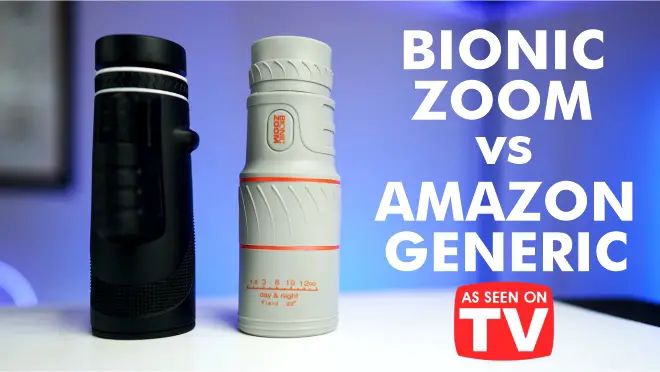Bionic Zoom is an As Seen on TV portable monocular scope that offers 8x magnification. I recently tested it out against a similar generic model on Amazon and today I offer the results of my tests.
Where to Purchase
You can pick up Bionic Zoom on Amazon or in stores such as Walmart. I bought mine at a local Walmart for about $30. Strangely, the original product website, buybioniczoom.com, now forwards to a page on the Spark Innovators website. The generic monocular telescope I bought on Amazon at this link cost me $35.88, although the last time I checked it had increased in price to over $50.
Features
According to their specifications, the Bionic Zoom offers 8X magnification, whereas the generic Amazon model claims to offer 80×100 magnification – which should be equivalent to 80x magnification (I will elaborate on that shortly). Both products are lightweight and portable. They feature an eyepiece adjustment and a single focus dial. The Amazon model comes with various accessories, such as a tripod, lens cap, phone adapter, and cleaning cloth. In contrast, the Bionic Zoom comes with only a cleaning cloth and protective pouch.
Bionic Zoom Review
I first found Bionic Zoom while perusing the As Seen on TV section of a local Walmart, and thought it would be fun to test out. I then went to Amazon to find a similarly priced model, and ended up with the generic model used for this review. The Amazon model initially cost $35.88, but its current price exceeds $50. I also noticed that the specified magnification of 80×100 seemed inaccurate as it would be 80x – ten times more than Bionic Zoom, which was not the case. In fact, in my tests, the Bionic Zoom seemed to have slightly higher magnification than the Amazon generic, not ten times less.
Despite the mislabeled magnification, I decided to take both scopes to a nearby bird preserve for a good old-fashioned bird-watching comparison. Upon testing, it became evident that the Amazon model provided better clarity than the Bionic Zoom, which had a slight fish-eye effect and blurriness around the edges. To demonstrate the difference, I used the phone attachment that came with the Amazon model to film through both units, then zoomed in with an old iPhone XS Max to compare the quality of all three.
The footage clearly showed that the Bionic Zoom skewed the edges and appeared slightly out of focus as it moved away from the center. Although it provided a modest improvement in magnification, even my old iPhone, which has a maximum 6X magnification, had better clarity and overall coverage.
Ultimately, your satisfaction with either product depends on how you use them and what you expect from them. For simple bird-watching or similar activities, I believe they perform reasonably well. However, for taking photos or videos, they are not better than simply zooming in your phone. Moreover, I am uncertain if I would choose either of these over a regular pair of binoculars. Still, if I had to select between the two, I would choose the Amazon model at its original price of $35.88. However, I do not believe it is worth over $50, as it is currently listed.


